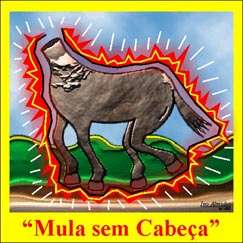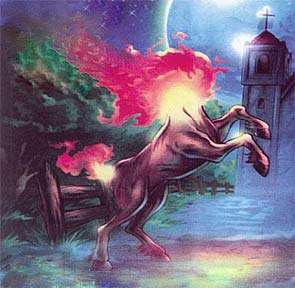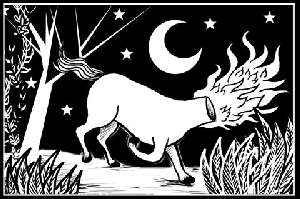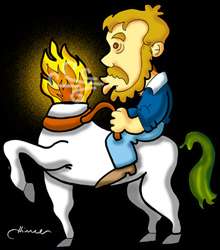A
Brasilian
Legend

Mule-Without-Head
This is a
not very
good
translation
I did of
this story,
the terms
are not very
easy for me,
as they are
in Brazilian
Portuguese
and some of
those words,
I have never
heard lol. I
tried to
find a
translation
at the web,
but it was a
mission
impossible.
As a fact
this story
was sent to
me by
Fernanda who
had sudden
to get on
LOA as she
lost her
father.
Í almost
forgot this
one in the
folder. She
was asking
for help to
translate
it, so you
can imagine
the text
wasn't at
all easy lol.
But in
respect to
Fernanda who
did the
effort to
get me a
legende from
Brazil to
take part of
the Myth
pages, I
wanted to go
ahead and
translate,
even badly,
and here it
is for your
joy, if you
can
understand
what I did
Lol. Anyhow
I want to
thank you
MzFe for to
have sent
this in and
the story is
quite
amazing *S*
I will leave
the original
here below.

Mule-Without-Head
"There is
still this
mule without
the head; it
brings still
pain, but
however.
These things
of Gods
mind...
nobody
should moan.
Mother came
you know,
yet after a
long time,
these people
is
uncommunicable...
"
(Manuel
Ambrósio.
Interior
Brazil)
* * *
The
transformation
in mule is
the
punishment
received for
the woman
who if
delivers to
a priest
sexually.
Into the
nights of
Thursday to
Friday, or
in
accordance
with the
moon, or of
seven in
seven years,
or quaresma,
at last -
the periods
vary of
region for
region - the
concubine
change and
depart into
headless
gallop,
stepping on
everything
what it
finds at the
front.
Its hooves,
very sharp,
wounds as
razors. When
it returns
home, it
turns backto
a human
being,
however it
is hurt,
abated, full
of
excoriations.
In the next
fatal night,
everything
happens
again.
So that the
concubine if
does not
transform,
the priest
must curse
it before
celebrating
each mass.
According to
Pereira da
Costa, this
must be made
before
touching the
Host, at the
moment of
the
consecration.
When finding
a mule, is
necessary to
hide the
nails in
order to not
attract its
anger. That
one who will
have the
extreme
courage to
remove the
brake of
iron in the
mouth, will
break the
enchantment.
In some
places, it
is enough to
cause a
wound, and
dripping its
blood.
The
mule-without-head,
donkey-of-priest
or burrinha
(donkey) are
myth of
Iberian
origin and
occur in all
America. In
Mexico, it
is called
malora; in
Argentina,
mule livens
up. Also it
is called
soul mule,
mule without
a head,
woman mule
and male
mule.
According to
Luís da
Câmara
Cascudo,
although
some
variations,
always the
"concubine"
punishment
is received
from the
priest.
Viriato
Corrêa is
The Flame of
the
Cavalacanga.
Innumerable
variations
exist on its
form: a mule
without
head, with
an appalling
whinny; a
black animal
with a cross
of white
coats in the
head; fire
eyes; it
moans as
people; it
whinnies; it
has a
luminous
torch in the
tip of the
tail; nobody
sees, only
hears it the
bustle; a
she-ass with
one stripes
white in the
neck...
Gustavo
Barroso
explains
that the
choice of
the mule, or
donkey, as
the
punishment
to the woman
of the
priest,
comes in
fact from
more or less
from the
Middle of
the Medieval
Age, the
mules was
the most
used for the
priests,
because they
were docile,
resistant
and safe.
Untiring
animals and
sufficiently
next to the
priests
person, also
physically.

Mula-sem-cabeça
"Ainda hai a
mula sem
cabeça;
custa muito,
mas porém
hai. Essas
cousas de
Deus unfum!...
ninguém deve
marmurá.
Mamãe veio
sabê, ô
dispois
muito tempo,
qu'essas
gente são
iscomungado..."
(Manuel
Ambrósio.
Brasil
interior)
* * *
A
transformação
em mula é o
castigo
recebido
pela mulher
que se
entrega
sexualmente
a um padre.
Nas noites
de quinta
para
sexta-feira,
ou de acordo
com a lua,
ou de sete
em sete anos,
ou na
quaresma,
enfim — os
períodos
variam de
região para
região — a
concubina
transforma-se
e parte em
galope
desvairado,
pisoteando
tudo o que
encontra
pela frente.
Seus cascos,
afiadíssimos,
ferem como
navalhas.
Quando
retorna à
casa,
readquire a
forma humana,
porém está
machucada,
abatida,
cheia de
escoriações.
Na próxima
noite
fatídica,
tudo
acontece
novamente.
Para que a
manceba não
se
transforme,
o padre deve
amaldiçoá-la
antes de
celebrar
cada missa.
Segundo
Pereira da
Costa, isso
deve ser
feito antes
de tocar a
hóstia, no
momento da
consagração.
Ao encontrar
uma mula, é
preciso
esconder as
unhas a fim
de não
atrair a sua
ira. Aquele
que tiver a
coragem
extrema de
retirar-lhe
o freio de
ferro da
boca,
quebrará o
encanto. Em
alguns
lugares,
basta
causar-lhe
um ferimento,
tirando-lhe
sangue.
A
mula-sem-cabeça,
burrinha-de-padre
ou burrinha
é mito de
origem
ibérica e
ocorre em
toda a
América. No
México, é
chamada
malora; na
Argentina,
mula anima.
Também é
chamada alma
mula, mula
sin cabeza,
mujer mula e
mala mula.
Segundo Luís
da Câmara
Cascudo,
apesar de
algumas
variações,
sempre é a
punição
recebida
pela "manceba"
do padre.
Viriato
Corrêa a
chama de
cavalacanga.
Existem
inúmeras
variações
sobre a sua
forma: uma
mula sem
cabeça, com
um relincho
apavorante;
um animal
preto com
uma cruz de
pêlos
brancos na
cabeça;
olhos de
fogo; geme
como gente;
relincha;
tem um facho
luminoso na
ponta da
cauda;
ninguém a vê,
só se ouve o
tropel; uma
burra com
uma listra
branca no
pescoço...
Gustavo
Barroso
explica que
a escolha da
mula, ou
burrinha,
como a
punição da
mulher do
padre, deve-se
ao fato que
desde mais
ou menos
meados da
Idade Média,
as mulas
foram as
montarias
mais
utilizadas
pelos
padres, por
serem dóceis,
resistentes
e seguras.
Animais
incansáveis
e bastante
próximos da
pessoa do
padre,
inclusive
fisicamente.

Thank you
MzFe for
your
contribution
*S*